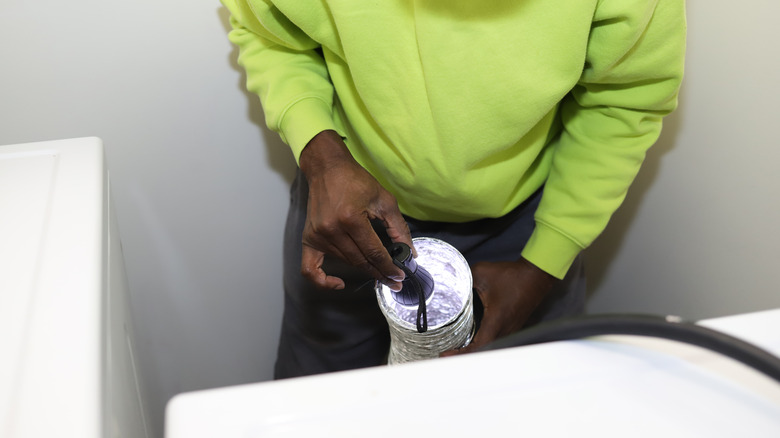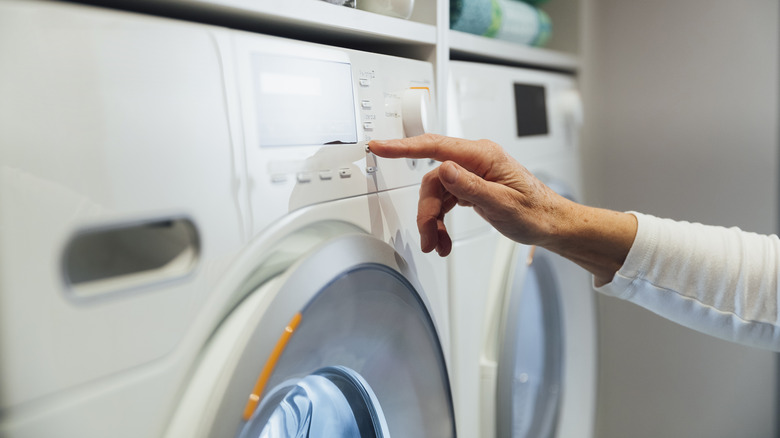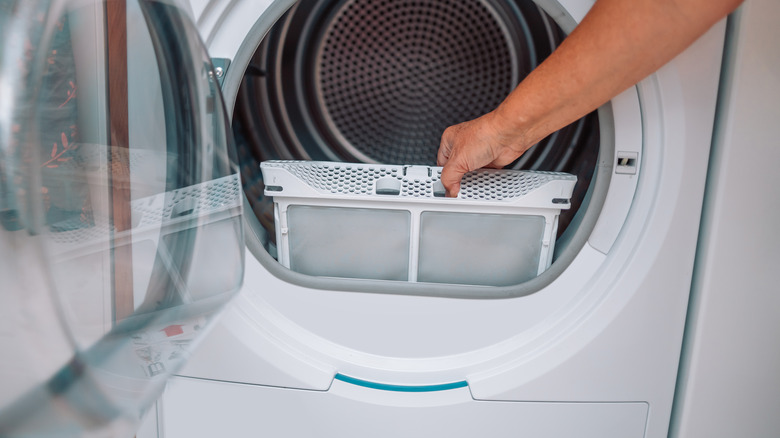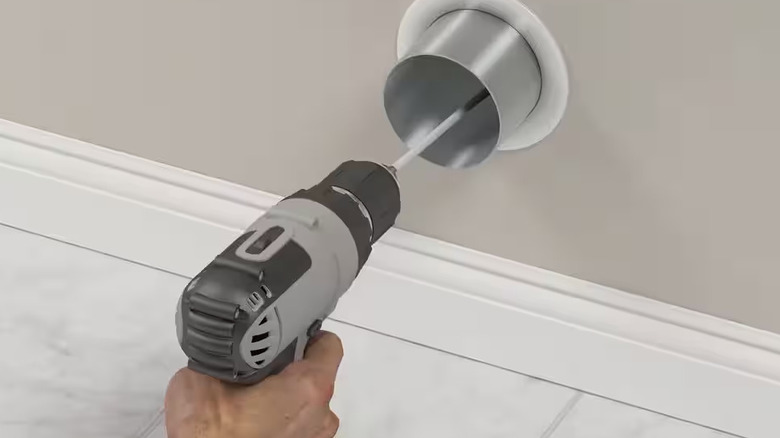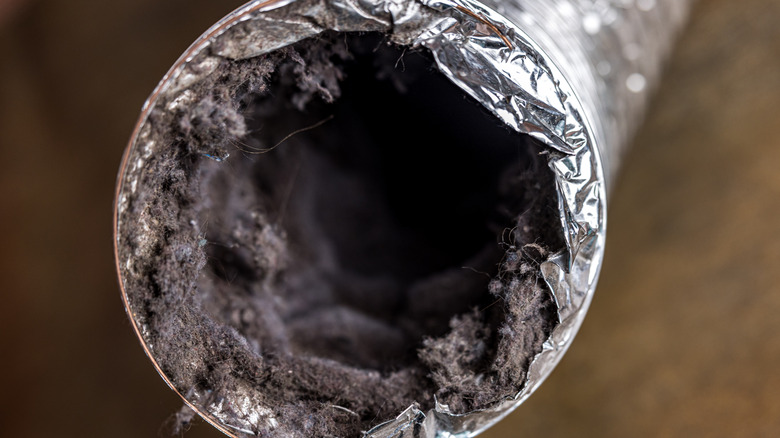5 Surefire Signs You Need To Clean Your Dryer Vent
What a wondrous and yet forgettable invention your dryer vent is. This part of your appliance traps all the lint, hair, dust, and other detritus that clings to your clothes and leaves them looking fresh after a cycle. It helps reduce allergens that also stick to fabrics and allows your dryer to work efficiently so your items are warm and ready for wear. It can be easy to overlook tell-tale signs that your dryer vent needs a good clean, and just removing the lint trap collection isn't always enough to ensure both your appliance and your clothes stay in good condition. Signs like a slower dry process, fabrics that are warmer than usual, and alerts from your machine could indicate you need to properly clean it for better results. Knowing effective ways to clean your dryer vent helps keep it in good repair, too.
You should be cleaning this vent at least once a year by getting in there with a vent brush or vent-cleaning kit like this Home Depot option ($26.40). The items included in kits like these allow you to really get into the nooks and crannies to remove lint that has escaped the trap. Over time, these wayward pieces can build up, creating issues with your dryer and hazards you want to avoid.
Long drying times
One of the most obvious signs that your dryer vent needs a good clean is that your clothes are taking longer to dry. According to the Maytag and Whirlpool websites, the average dryer cycle lasts around 45 minutes, so if your loads require longer or you have to put the timer on a second time, the vents are likely clogged. To properly clean it, you want to start by disconnecting the duct, which can be found behind the dryer. Make sure you've unplugged the appliance completely first. The duct is the silver aluminum tube that connects the dryer to the wall. Use a vacuum to suck up all the lint at the entrance to both the duct and the exhaust.
Using a HEPA vacuum filter is recommended because it assists with clearing away pollutants that appear in lint and other dryer detritus in the form of small particles. These can cause allergies or breathing difficulties for those with asthma or other similar issues.
Your dryer is displaying error codes
Sometimes, you don't even need to look for signs your dryer vent needs to be attended to; the machine will just tell you. Many smart dryers now come with the capability to alert users that it's time to clean the lint trap, and while you should do this after every load, it might be worth checking your vent if this notice comes up more frequently than usual (although some appliances notify you after every use, in which case stick to cleaning the vent at least once every 12 months). If your dryer is continuously telling you to clean the vent, once you've emptied the lint trap, look at the duct to ensure there are no bends or kinks. This can contribute to a clog or error code and could create a buildup if particles get stuck and collect in the duct or vent.
Once you've cleaned all the pieces you have access to, including the slot where the trap resides, try to turn on a dryer cycle and see if the code persists. If it does, you might need to enlist the help of a professional who will check your entire venting system to remove blockages or other problems that could be affecting your dryer.
You smell burning, and nothing is cooking
Even if you're notoriously bad at cooking, smelling a burning scent is never an ideal situation. If you're not even preparing any food, getting a whiff of something being singed is downright frightening. Clogged lint traps and dryer vents are hazardous and can be flammable. According to Envista Forensics, 92% of house fires as of 2022 were caused by clogged vents or an excess of lint that accumulated in the machine. These are avoidable circumstances and only require homeowners or renters to check the traps and vents regularly.
Should you smell something burning while your dryer is on, it's time to take a look at your machine and assess what could be causing the problem. Use your HEPA vacuum to clear out the drum, lint trap hole, and rollers, which are located under your dryer drum. This does require you to open the cabinet that protects the fittings and take the actual drum out, but the alternative is much worse, and this will ensure your appliance works safely and effectively after you've cleaned it.
The heating isn't on, but it's too warm in the laundry room
Another sign is an uncomfortably hot laundry area. If the space where your dryer is kept gets too warm whenever the appliance is in use, you might have an overly full or blocked vent. While TikTok trends might recommend using your dryer to cut down on heating bills, this isn't a good sign if it's happening on its own. If your clothing and linens are coming out super hot, too, the same reasons could be responsible. Dryer vent kits are available at stores like Home Depot, or you can snag one online. These include long rods that connect to create one long device used to get inside the duct coming out from your wall. Most kits allow you 12 feet of rods, so you can remove lint that has blown deeper than a vacuum can reach.
Inside the kit, you will also find a rotating brush. This is meant to be attached to the end that inserts into your duct, which will remove stuck-on lint and detritus. You will want to have a power drill ready because it goes on the end of the rod without the brush to make the entire length spin, effectively capturing whatever might be clogging the interior tunnel. Set the drill to turn clockwise, and slowly insert it as far as you can, gently reinserting it a few times. If grime and buildup begin coming out, you will know the process is working, and your vents should be ready for another cycle once you're finished!
You've reached the 12-month cleaning mark
Your dryer might seem like it's working fine, and therefore the vents don't need attention at the 12-month mark that is recommended when it comes to cleaning them out. While this logic seems sound, the inside of your duct and vent is showing a very different situation. With every use, your dryer is produces lint pulled from clothing and linens, which collects in the lint trap. These particles can still accumulate outside the trap and work their way into the vent over time. A few weeks or months' worth of lint might not be cause for concern, but after a year, the build-up could be considerable. This is why detaching the vent and cleaning both it and the duct is important.
Many cities have companies that will come out and do the work for you, so if this task isn't something you are comfortable undertaking, why not hire a professional and save the stress? They will check everything from the inside out since they are experts on how to clean the exterior dryer vent, too, to ensure all the lint is cleared.
